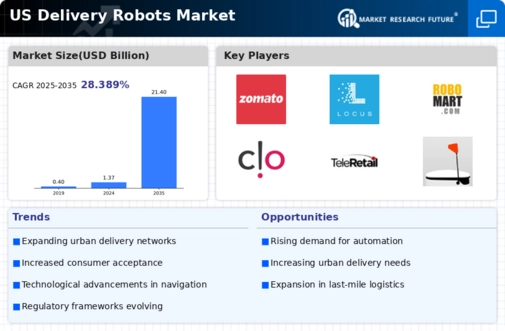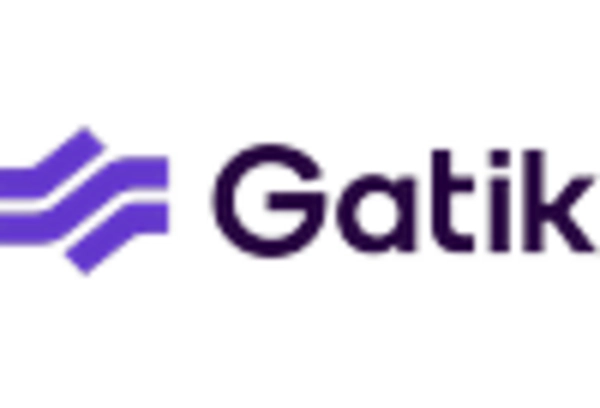Growing Demand for Contactless Delivery
The increasing consumer preference for contactless delivery options is a pivotal driver in the delivery robots market. As e-commerce continues to flourish, particularly in urban areas, the demand for efficient and safe delivery methods has surged. According to recent data, the e-commerce sector in the US is projected to reach approximately $1 trillion by 2025, which inherently boosts the need for innovative delivery solutions. Delivery robots, offering a contactless experience, align with consumer expectations for safety and convenience. This trend is likely to propel the adoption of delivery robots, as businesses seek to enhance customer satisfaction while minimizing human interaction. Consequently, the delivery robots market is expected to expand significantly, driven by this evolving consumer behavior.
Sustainability and Environmental Concerns
Sustainability is becoming a critical consideration for consumers and businesses, influencing the delivery robots market. With growing awareness of environmental issues, there is a shift towards eco-friendly delivery solutions. Delivery robots, which typically operate on electric power, present a greener alternative to traditional delivery methods that rely on fossil fuels. The logistics sector is responsible for approximately 29% of greenhouse gas emissions in the US, prompting companies to seek sustainable practices. By adopting delivery robots, businesses can reduce their carbon footprint and appeal to environmentally conscious consumers. This trend towards sustainability is likely to drive the adoption of delivery robots, as companies strive to align with consumer values and regulatory expectations.
Investment and Funding in Robotics Startups
The delivery robots market is witnessing a surge in investment and funding directed towards robotics startups. Venture capitalists and private equity firms are increasingly recognizing the potential of delivery robots to transform logistics and last-mile delivery. In 2025, investments in robotics are projected to exceed $10 billion in the US, indicating a strong belief in the future of this technology. This influx of capital enables startups to innovate and enhance their delivery robot offerings, leading to improved functionalities and market competitiveness. As these startups develop more advanced solutions, the delivery robots market is likely to experience accelerated growth, driven by the continuous evolution of technology and increased consumer demand.
Advancements in Robotics and AI Technologies
Technological advancements in robotics and artificial intelligence (AI) are significantly influencing the delivery robots market. Innovations in navigation systems, machine learning, and sensor technologies have enhanced the capabilities of delivery robots, making them more efficient and reliable. For instance, the integration of AI allows robots to learn from their environments, improving their ability to navigate complex urban landscapes. The market for AI in the robotics sector is expected to grow at a CAGR of over 30% through 2025, indicating a robust investment in these technologies. As delivery robots become more sophisticated, their adoption is likely to increase, thereby driving the overall growth of the delivery robots market. This technological evolution is essential for meeting the rising expectations of consumers and businesses alike.
Urbanization and Last-Mile Delivery Challenges
Rapid urbanization in the US is creating significant challenges for last-mile delivery, which is a crucial aspect of the delivery robots market. As more people migrate to urban centers, the demand for efficient delivery solutions intensifies. The last-mile delivery segment accounts for nearly 53% of total logistics costs, highlighting the need for cost-effective alternatives. Delivery robots present a viable solution to these challenges, as they can navigate congested urban environments and reduce delivery times. Furthermore, the integration of delivery robots into urban logistics could potentially lower operational costs for businesses, making them an attractive option for companies looking to optimize their delivery processes. This urbanization trend is likely to drive the growth of the delivery robots market.
















Leave a Comment